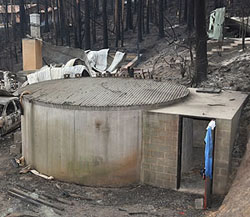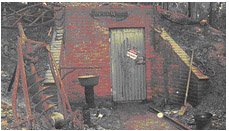Fire Bunkers
Things to Consider
There is currently no Australian Standard or Building Code recognition of fire bunkers although there has been heightened interest in them in the wake of the February 2009 bushfires.
 Interim Fire Bunker Guidelines now apply in Victoria.
Interim Fire Bunker Guidelines now apply in Victoria.
Because of the lack of Standards and available performance data a fire bunker is no guarantee of safety, thus a detailed evacuation and fire plan is still the best option. The few who survived the February 2009 bushfires by using a fire shelter or bunker of some sort, described it as a 'hellish experience' which they would not want to repeat.
Making the decision to leave all of your belongings, or to stay and defend may be the most difficult decision you ever have to face.
That said, in the instance that you have not received sufficient warning, or are trapped in a firestorm, a fire bunker may be your only option.
**NOTE- The following article is intended to stimulate thought on fire bunkers and whether they are an option you are willing to consider, not as a prescriptive 'how to' guide.
A fire bunker / safety shelter needs to
perform in several ways-
- protect from radiant heat, air, embers, falling trees and buildings
- provide a safe place for family members (and pets) as the fire passes and maintain a reasonable internal temperature for at least 30 minutes
- provide space for supplies- fire protection (for immediately after the fire), blankets, water, torches, radio, first aid kit and other essentials
- be a safe space in the aftermath of the fire
You have the option to either build/design your own fire bunker, or there are commercial prefabricated fire bunkers available, but you will need to undertake due diligence in examining their reliability.
Basic Considerations for a Fire Shelter / Bunker
Location and Use - Under the house- not recommended as the structure would need to withstand the weight (and extended burning time) should your house collapse on top of it. This may also limit exit from the bunker.
- Dual use- this might be a way to justify the cost, but the specific design requirements of a fire bunker make it unlikely that it could be dual purpose.
- Preferred- away from the house, trees and boundaries, but easy to access from house.
Design
- Fire door- is a must. Preferably the bunker will have two doors, so that the inner door is not exposed to direct heat in which case it may fail.


- Construction Materials- be able to withstand direct heat, maintain a seal for the safety of occupants. The structural integrity of the bunker is the most important aspect of the design.
- Earth Berm- partly covering the structure with earth may require extra engineering and consideration for drainage/flooding, but provides both insulation from the heat of the fire and protects the actual structure from fire damage. **NOTE- the two examples pictured (right) from the Feb 2009 fires were both protected by earth on at least one side.
- External Vent- needs to be openable after the fire front has passed. Fumes may be an issue so handheld face masks might be a consideration. **NOTE- This is still a contenscious topic with varied opinions.
- Size- large enough for family members, and to store necessary equipment and supplies, and to provide enough air supply for everyone for at least 30 minutes.
Other Considerations
- Price
- Council Permits- are required for building works, although nothing currently exists in regards to fire bunkers. Building Regulations are currently being established but are not yet in place.
- Engineering- it is worth paying to have a sound structure.
- Safety of the structure outside of fire season - the fire bunker must NOT be a locked building, for access during fires, but poses a potential risk at other times - children need to be educated that it is not a cubby of any sort.
- Regular Maintenance- check doors, vents, supplies
- Avoid any flammable or gaseous materials in the bunker
Again the bunker must be seen as a place of last resort.
Evacuate early and avoid being in the path of the fire altogether.
Recent recommendations for Neighbourhood Safer Places as places of 'last resort' have been implemented in some locations, but are unavailable in others due to high levels of vegetation.
 Home from Fire Bunkers
Home from Fire Bunkers
Fire Safety . Green News
Home | Site Map | Site Policies | Contact Me






